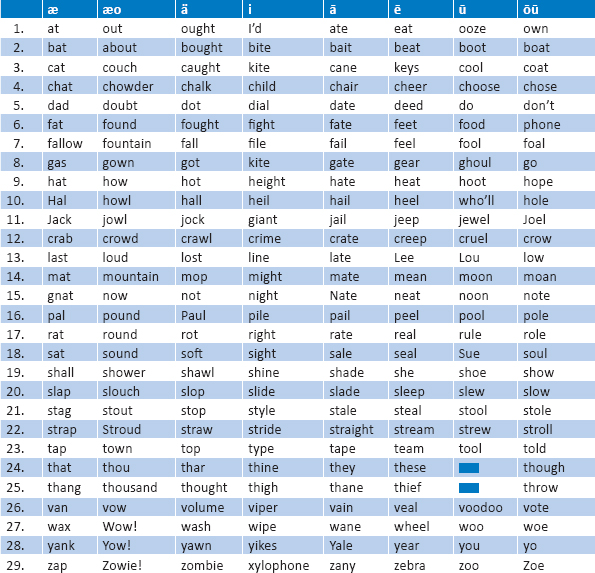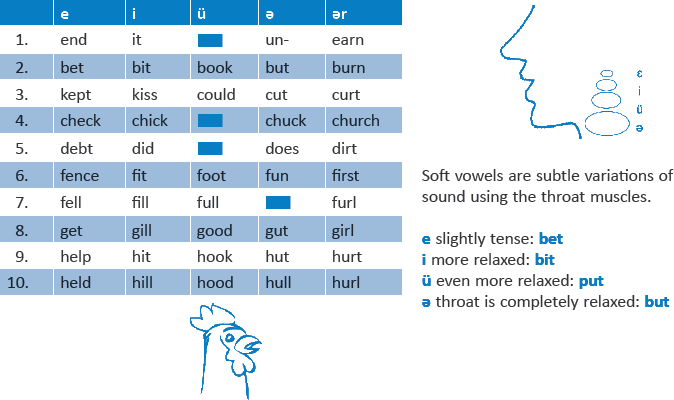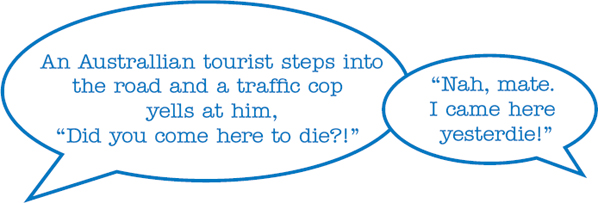
Move your lips for tense vowels, but not for lax vowels.
In this chapter, we tackle tense and lax vowels. This is the difference between ā, tense, and ε, lax; ē, tense, and i, lax. We will start with tense vowels. (See also Chapters 1, 3, and 10.)
Exercise 12-1: Tense Vowels |
Don’t pay attention to spelling or meaning. Just remember, if you are in the ä column, they all have the same ah sound. Repeat.

Go through the subsequent paragraph and mark all the tense vowels, starting with ā (there are 12 here). The first one is name (nεim, not nεm). The first ē sound (15) is the American. (The same 5 æ sounds can be found as in Exercise 3-2, plus the æo of sound and down. Do the marking. (Click here for Answers.)
Hello, my nāme is______________. I’m taking American æccent Training. There’s a lot to learn, but I hope to make it as enjoyable as possible. I should pick up on thē American intonation pattern pretty easily, although the only way to get it is to practice all of the time. I use the up and down, or peaks and valleys, intonation more than I used to. I’ve been paying attention to pitch, too. It’s like walking down a staircase. I’ve been talking to a lot of Americans lately, and they tell me that I’m easier to understand. Anyway, I could go on and on, but the important thing is to listen well and sæond good. Well, what do you think? Do I?

Tense vowels use the lips and jaw muscles.
Exercise 12-3: Lax Vowels |
These are the lax vowels (as we saw in Chapter 10).

Again, go over this paragraph and mark the lax vowels, starting with ε. The first one (of about 12 possible) is in hello or American. The first i sound (of 9 to 22) may be found in is. (The numbers are approximations because you may have already reduced the ε of hello and the i of is into schwas.) Do the marking. (Click here for Answers.)
Hello, my name is______________. I’m taking American Accent Training. There’s a lot to learn, but I hope to make it as enjoyable as possible. I should pick up on the American intonation pattern pretty easily, although the only way to get it is to practice all of the time. I use the up and down, or peaks and valleys, intonation more than I used to. I’ve been paying attention to pitch, too. It’s like walking down a staircase. I’ve been talking to a lot of Americans lately, and they tell me that I’m easier to understand. Anyway, I could go on and on, but the important thing is to listen well and sound good. Well, what do you think? Do I?
Exercise 12-5: Take a High-Tech Tack |
Repeat the following paragraph and words after me.
Sāy, Rāy, tāke a tack. A high-tack tack? No, Rāy, a high-tech tack, eight high-tech tacks, tāke them. Then find a wāy to māke a plāce for the tacks on the dāy bed. Hey, you lāy the tacks on the pāper plāce mat on the tāble, not on the dāy bed, Rāy. At your āge, why do you always māke the sāme mistākes?


Exercise 12-6: Pick a Peak |
Repeat the following paragraph and words after me. Boldfaced elements represent the ē sound. The i is marked only with underscoring.
People who pick peaks weekly seem to need to appear deep in order to be distinguished from mere pea pickers. Peter, a champion peak picker, thought he’d be even neater if he were the deepest peak picker in Peoria, Phoenix, and New Zealand. On his peak peak-picking week, though, Peter, a peak picker’s peak picker, realized that he was not deep. This is not easy for a peak picker to admit, and it pitched Peter into a pit of peak-picking despair. He was pitiful for three weeks and then lifted himself to hitherto unrevealed personal peaks.


